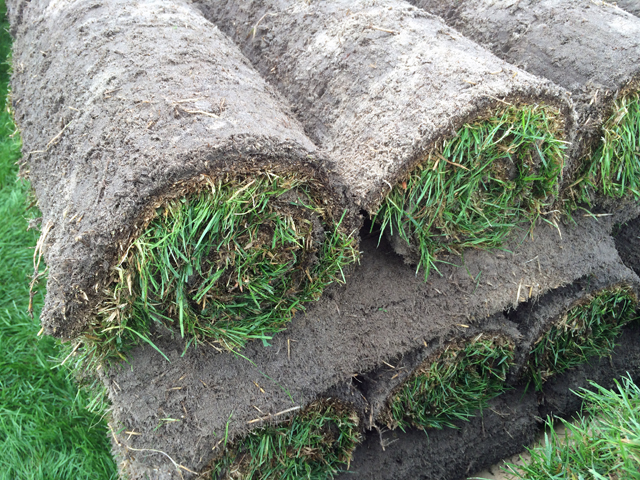
Best management practices are vital to the successful production of sod by Florida producers who strive to be in compliance with governmental regulations. Credit: Bryan Unruh
Bryan Unruh, UF/IFAS Turf Specialist
Sod production in Florida contributes approximately $300 million to the state’s economy annually. As the economy continues to rebound and new houses are built to accommodate Florida’s population growth, sod will also see an increase in demand, which bodes well for Florida’s sod producers.
Best management practices (BMPs) provide producers with critical tools they need to produce quality turfgrass sod while complying with local, state and federal regulations. Sod production BMPs cover the gamut of production practices ranging from nutrient management, irrigation and water table management, water resource protection, integrated pest management, chemical waste management, and pollinator protection. An area of primary concern for sod producers is the protection of surface waters from pollutants, including fertilizer, and nearly every state in the U.S. is affected by Federal legislation such as the U.S. Clean Water Act, which was passed by the U.S. Congress in 1972.
Water quality has been decreased by point and nonpoint source pollution. Section 502(14) of the U.S. Clean Water Act defines point source as any “discernible, confined and discrete conveyance, including but not limited to any pipe, ditch, channel, tunnel, conduit, well, discrete fissure, container, rolling stock, concentrated animal feeding operation, or vessel or other floating craft, from which pollutants are or may be discharged” (1). Conversely, nonpoint source pollution is defined to mean any source of water pollution that does not meet the legal definition of point source in the U.S. Clean Water Act. Nonpoint source pollution comes from many different sources including land runoff, precipitation, atmospheric deposition, drainage, seepage or modifications to natural waterways. Nonpoint source pollution occurs as rainfall or snowmelt moves over the surface and through the ground picking up natural and man-made pollutants and then depositing them into lakes, rivers, wetlands, coastal waters and ground waters. Across the state of Florida, nonpoint source pollution is the leading cause of water-quality problems that adversely affect drinking water supplies, recreation, and marine life and wildlife.
A common approach to driving water quality improvement is the development and implementation of urban and agricultural BMP programs. The term “BMP” in Florida has a statutory definition:
Best management practice means a practice or combination of practices determined by the coordinating agencies, based on research, field-testing, and expert review, to be the most effective and practicable on-location means, including economic and technological considerations, for improving water quality in agricultural and urban discharge. (373.4595, F.S.).
This definition ensures that the BMPs are based on sound science that is verifiable and peer-reviewed and that they are not economically impractical to the sod producer.
In 2005, the Florida Department of Agriculture and Consumers Services (FDACS) established a steering committee to guide the development of sod production BMPs. The steering committee, comprising regulatory officials and sod producers, worked closely with UF-IFAS faculty and other producers to publish the Water Quality/Quantity Best Management Practices for Florida Sod Manual in 2008. In 2017, FDACS initiated a revision of this statewide BMP manual for sod operations to clarify and update the practices in the original manual; the revision is forthcoming.

In 2017, The Florida Department of Agriculture formed a steering committee to clarify and update the practices in the original Sod Production BMP Manual published in 2008. Credit: Bryan Unruh
Benefits of Implementing BMPs
Benefits to enrolling in and implementing FDACS BMPs include:
- Maintaining support for this non-regulatory approach to meeting water quality and conservation goals through demonstrating agriculture’s commitment to protecting water resources.
- Some BMPs increase production efficiency and reduce costs.
- Eligibility for cost share (as available) and technical assistance to help with BMP implementation.
- A presumption of compliance with state water quality standards for the pollutants addressed by the BMPs.
- Release from fines for damages imposed under section 376.307(5), F.S., for pollutants addressed by the BMPs.
- Producers implementing BMPs gain certain protections since The Florida Right to Farm Act (section 823.14, F.S.) generally prohibits local governments from regulating an agricultural activity that is already adopted.
For more information on the Florida BMP Program, and the BMPs identified for sod production, use the following links:
Florida Agricultural Best Management Practices website
2008 Sod Production BMP Manual
Enroll Your Farm in the Florida BMP Program
Literature cited
- S. Environmental Protection Agency (EPA). 2016. Clean Water Act, Section 502 General definitions. www.epa.gov/cwa-404/clean-water-act-section-502-general-definitions Accessed Nov. 29, 2016.
- Southern Scientists are Collaborating to Develop Drought Resistant Turfgrasses - September 7, 2018
- Florida Sod Production BMP Manual is Being Revised - January 26, 2018
